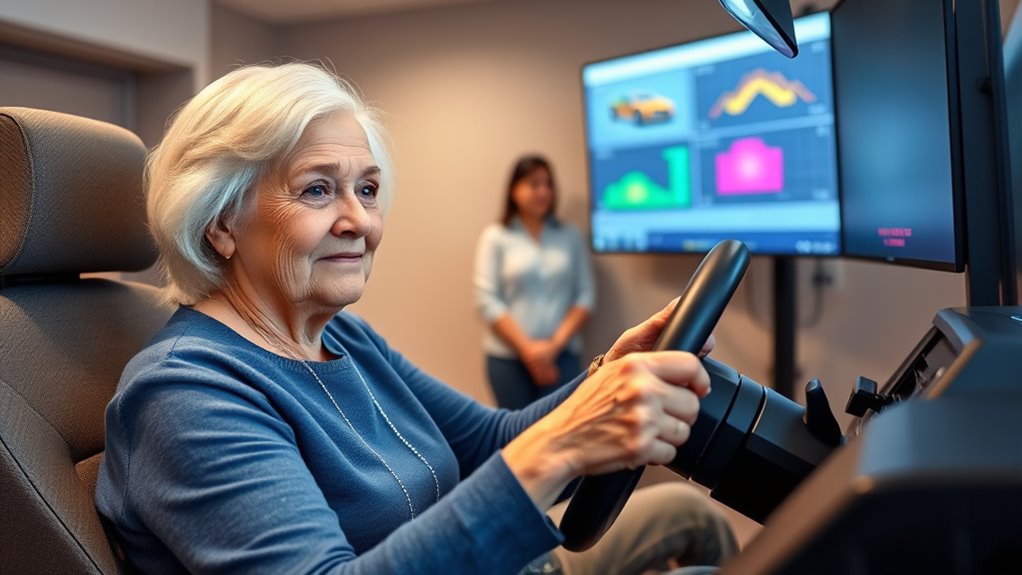A safe driving assessment for seniors helps determine if you can drive safely as you age. It covers vision, cognition, mobility, and vehicle maintenance to spot any issues. Healthcare professionals review your medical history and may suggest adjustments or alternatives when needed. Staying aware of age-related changes, like slower reactions or vision decline, is essential. Keep exploring to learn more about how to stay safe and maintain independence on the road.
Key Takeaways
- Regular evaluations assess vision, cognition, and mobility to determine driving safety for seniors.
- Comprehensive assessments include functional testing and review of medical history to identify impairments.
- Age-related changes like vision decline and slower reaction times require adaptive driving strategies.
- Use of advanced vehicle technologies and automation supports safer driving for seniors.
- When necessary, alternative transportation options help seniors maintain independence safely.
Understanding the Importance of Driving Evaluations for Older Adults

As we age, physical and cognitive changes can affect your ability to drive safely. That’s why understanding the importance of driving evaluations is vital. Regular assessments help identify any impairments that could compromise your safety or that of others. Maintaining your vehicle properly through regular vehicle maintenance ensures it operates safely and reduces the risk of breakdowns or accidents. Additionally, being prepared for emergencies—like sudden health issues or road hazards—can make a significant difference. Driving evaluations also provide guidance on adapting to changes, such as using assistive devices or adjusting driving habits. Incorporating sustainable health strategies can support overall well-being, helping you maintain the skills necessary for safe driving. Staying engaged in preventive health care can further contribute to your ability to drive safely. Overall, these assessments promote safer driving, helping you stay confident and independent while safeguarding everyone on the road.
Components of a Comprehensive Driving Assessment

A thorough driving assessment evaluates multiple aspects of your ability to operate a vehicle safely. It begins with an evaluation of driving ergonomics, ensuring your seat position, mirrors, and controls support comfortable and clear visibility, reducing fatigue and distraction. Proper ergonomics help you maintain focus and react promptly. The assessment also covers vehicle maintenance, checking that your vehicle is in good working order—brake function, tire pressure, lights, and signals—to prevent accidents caused by mechanical issues. These components work together to create a safe driving environment. Additionally, automation technologies can assist in monitoring vehicle systems and alerting drivers to potential issues, further enhancing safety. Incorporating regular vehicle checks into your routine ensures ongoing safety and performance. Also, using essential oils in your vehicle can help promote alertness and reduce stress during drives, contributing to safer driving habits. Regularly practicing safe driving techniques can further improve your overall driving skills and confidence on the road. Being aware of local store hours can help you plan vehicle maintenance visits or shopping trips conveniently. By addressing both ergonomic setup and vehicle upkeep, you can enhance your driving safety and confidence on the road. This all-encompassing approach helps identify areas needing improvement, supporting your independence and well-being.
How Age-Related Changes Impact Driving Abilities

As you age, your vision might become less sharp, making it harder to see road signs and pedestrians clearly. Your reaction times also slow down, which can affect how quickly you respond to sudden hazards. Additionally, cognitive processing declines may impact your ability to multitask or make quick decisions while driving.
Vision Changes Reduce Clarity
Age-related changes in vision can markedly impair your ability to see clearly while driving. These changes can lead to vision impairment, making it harder to distinguish signs, read gauges, and detect obstacles. To maintain eye health and safe driving, be aware of:
- Reduced night vision, making it difficult to see in low light conditions
- Decreased visual acuity, affecting sharpness and detail recognition
- Increased glare sensitivity, causing discomfort from headlights or sunlight
- Narrowed peripheral vision, limiting awareness of side objects and pedestrians
Additionally, understanding how energetic alignment can influence overall well-being may inspire proactive health practices to support your safety. As advancements like the Snapdragon 8 Gen 3 integrate AI to enhance device capabilities, staying informed about vision health remains vital for safe mobility. Recognizing potential AI vulnerabilities in diagnostic tools can further support early detection and prevention of vision-related issues. Regular eye examinations and monitoring of vision changes are essential to adapt to these age-related adjustments and maintain optimal driving safety, as new technologies and screen time habits continue to impact eye health.
Slower Reaction Times
Because your reaction times tend to slow down with age, responding quickly to sudden changes on the road becomes more challenging. When your reaction time is slower, you may not brake or steer as promptly, increasing the risk of accidents. This can also lead to unintentional driving at higher speeds, making it harder to adjust to unexpected hazards. As your reaction time decreases, maintaining safe driving speed becomes vital, since quick adjustments are more difficult. Being aware of this change helps you stay alert and proactive. You might find it helpful to give yourself extra space between vehicles and avoid situations that require rapid responses. Recognizing slower reaction times allows you to adapt your driving habits, promoting safety for yourself and others on the road. Incorporating contrast ratio awareness into your driving approach can help reduce risks associated with slowed reactions, as understanding visual perception changes supports safer decision-making. Additionally, staying informed about age-related cognitive changes can further aid in adjusting your driving strategies effectively. Regular check-ups and vision assessments can also help monitor and address visual processing changes that impact driving safety.
Cognitive Processing Decline
Cognitive processing decline can make it harder to interpret and respond to complex driving situations quickly. You may notice challenges with memory recall, making it harder to remember routes or traffic rules. Decision making can also slow, affecting your ability to choose the best action in sudden situations. To help, consider these tips:
- Stay alert and minimize distractions while driving.
- Plan routes ahead of time to reduce memory load.
- Allow extra time for decision making in traffic.
- Regularly update your skills through driving assessments.
- Understanding personal debt management can provide peace of mind, reducing stress that might affect concentration while driving. Additionally, incorporating glycolic acid in skincare routines can improve skin texture and overall health, which may boost confidence during outings. Being aware of home decor elements that promote a calming environment can also help reduce anxiety and improve focus while driving. Moreover, engaging in cognitive exercises such as puzzles or memory games can help maintain mental sharpness essential for safe driving. Research shows that mental sharpness can be maintained with consistent practice of such activities.
The Role of Healthcare Professionals in Safety Evaluations

Healthcare professionals play a crucial role in ensuring seniors can drive safely. They assess medical conditions that might affect driving, considering factors like vision, cognition, and mobility. When determining fitness to drive, they may review medical licensing requirements, ensuring seniors meet necessary health standards for licensing renewal. Legal considerations also influence their evaluations, as they must report any conditions that impair safe driving to authorities, balancing patient confidentiality with public safety. Your healthcare provider conducts thorough assessments, including medical history and functional testing, to identify potential risks. Their expertise guides recommendations for driving restrictions or cessation, helping seniors maintain independence while prioritizing safety. Additionally, understanding the diverse genres of entertainment seniors enjoy can support holistic assessments of their well-being. Ultimately, healthcare professionals serve as a critical link between medical insight and legal responsibilities in safeguarding everyone on the road.
Alternatives and Support for Seniors Who Need to Reduce Driving

When you need to reduce your driving, several options can help you stay mobile and connected. Community resources, like transportation services, can provide reliable substitutes, while adaptive driving technologies make vehicles safer to operate. Exploring these solutions guarantees you maintain independence without compromising safety.
Transportation Options for Seniors
As seniors consider reducing their driving, exploring alternative transportation options becomes essential. You can make travel easier and safer with various choices. First, public transportation offers affordable and accessible options, especially in urban areas. Second, ride sharing services like Uber and Lyft provide flexible, on-demand rides tailored to your schedule. Third, community shuttles or senior transportation programs often cater specifically to older adults’ needs. Fourth, carpooling with friends or family can be a reliable way to maintain independence without driving yourself. These options help you stay connected, attend appointments, and enjoy activities without the risks associated with driving. Additionally, understanding senior transportation options can help you make informed decisions about your mobility. Being aware of self watering plant pots and their benefits can also be a useful skill for maintaining your home environment, especially if you need to spend less time on household chores. By exploring these alternatives, you can confidently navigate your community while prioritizing safety and independence.
Community Support Resources
Supporting your mobility needs, community resources offer a range of services designed to help seniors who are reducing their driving. Community outreach programs connect you with local organizations that understand your transportation concerns and provide tailored solutions. Volunteer programs are especially valuable, allowing you to request rides for appointments, errands, or social activities, all while staying connected to your community. Many communities also offer transportation services such as shuttle buses or carpool networks, making it easier to maintain independence without driving yourself. These resources help you navigate changes in mobility smoothly, ensuring you remain active and engaged. By leveraging community support, you can confidently reduce your driving while still accessing the essentials of daily life.
Adaptive Driving Technologies
Adaptive driving technologies offer practical solutions to help seniors maintain mobility while reducing the need for traditional driving. Vehicle automation and adaptive controls make this possible by enhancing safety and ease of use. Here are some options to contemplate:
- Automatic braking systems that detect obstacles and slow the vehicle.
- Adaptive cruise control maintaining safe distances without constant input.
- Voice-activated controls for navigation, calls, and entertainment.
- Adaptive controls that modify the vehicle’s operation to accommodate physical limitations.
These technologies support safer driving experiences, allowing you to stay independent while reducing risks. Vehicle automation and adaptive controls are designed to complement your needs, making driving more comfortable and less stressful as you age.
Tips for Families to Support Safe and Independent Mobility

Families play a essential role in helping seniors maintain safe and independent mobility. You can support this by encouraging regular vehicle maintenance, ensuring brakes, tires, and lights are in good condition. Well-maintained vehicles reduce the risk of breakdowns and accidents, enhancing road safety for your loved ones. Offer to accompany them to check-ups or service appointments, making sure their vehicle is safe to drive. Additionally, stay involved in their driving habits by discussing routes, avoiding high-traffic areas, and respecting their comfort levels. You can also explore alternatives like public transportation or community shuttles when driving isn’t safe anymore. Your support helps seniors stay confident behind the wheel while prioritizing safety, ensuring they can enjoy independence without unnecessary risks.
Frequently Asked Questions
How Often Should Seniors Undergo a Driving Assessment?
You might wonder how often you should undergo a driving assessment. Based on frequency recommendations, it’s smart to get evaluated regularly, especially if you notice assessment triggers like vision issues, slower reaction times, or recent health changes. Typically, seniors are advised to have assessments every one to two years. Staying proactive helps guarantee your safety and confidence on the road, while also protecting others around you.
Are There Specific Signs That Indicate a Need for Evaluation?
If you’re wondering when to get evaluated, watch for signs like worsening vision impairments or delayed reaction time. You might notice difficulty seeing road signs, frequent close calls, or trouble staying in your lane. These signs suggest it’s time to contemplate a driving assessment. Trust your instincts and consult with your doctor if you experience these issues, ensuring your safety and the safety of others on the road.
What Costs Are Typically Associated With a Driving Assessment?
When you consider a driving assessment, you’ll want to know the costs involved. Typically, evaluation fees cover the actual assessment and can vary depending on the provider. Additionally, your insurance premiums might increase afterward, especially if the assessment results in restrictions or license modifications. It’s wise to check with your insurer and the assessment provider ahead of time to understand the total costs and any potential impact on your insurance.
Can Assessments Determine if a Senior Should Stop Driving Permanently?
Think of an assessment as a lighthouse guiding you safely through foggy waters. While it can reveal if a senior’s driver independence is compromised, it doesn’t always decide if they should stop driving forever. Assessments aim for high accuracy, but individual circumstances vary. Ultimately, they help determine if continued driving is safe, allowing seniors to make informed choices, rather than locking in a permanent decision prematurely.
How Do Cultural or Regional Differences Affect Driving Evaluations?
Cultural attitudes and regional road conditions considerably influence driving evaluations. You might find that in some areas, cultural norms prioritize independence, impacting how seniors are assessed for driving. Regional road conditions, like busy urban streets or rural terrains, also shape evaluation criteria. You should consider these factors because they affect the standards used, ensuring assessments are fair and relevant to the local environment and cultural expectations.
Conclusion
Ensuring your safety on the road is like steering through calm waters—you want smooth sailing and peace of mind. Regular driving assessments help you navigate the twists and turns with confidence, keeping you and others safe. With support from healthcare professionals and loved ones, you can enjoy the open road, feeling secure and independent. Remember, it’s about staying in control and embracing new ways to keep your journeys safe and enjoyable.









